Ethnic Groups Of Vietnam: An Ethnological Guide To Vietnamese Tribes – Rainforest Cruises
Culture
If you’re considering a trip to Vietnam, you’ll already know that it’s one of the most varied countries to visit when it comes to landscape, climate, and culture. From the limestone islets of Halong Bay to the megacities of Hanoi and Ho Chi Minh City and all in between – it’s a land of extremes, that’s for sure.
What you might not realize is just how diverse Vietnam is within its actual population. Unbelievably, there are a mighty 54 ethnic groups in total in Vietnam, 53 of which are ethnic minorities. Altogether, ethnic minorities account for roughly 10 to 15 percent of the country’s total population of roughly 95 million.
But where do the tribes of Vietnam actually live? How do their lives differ from the rest of Vietnam’s population? Read on for a virtual tour of the highland villages of this fascinating country of Southeast Asia. Consider this your window into the lives of ethnic minorities in Vietnam.
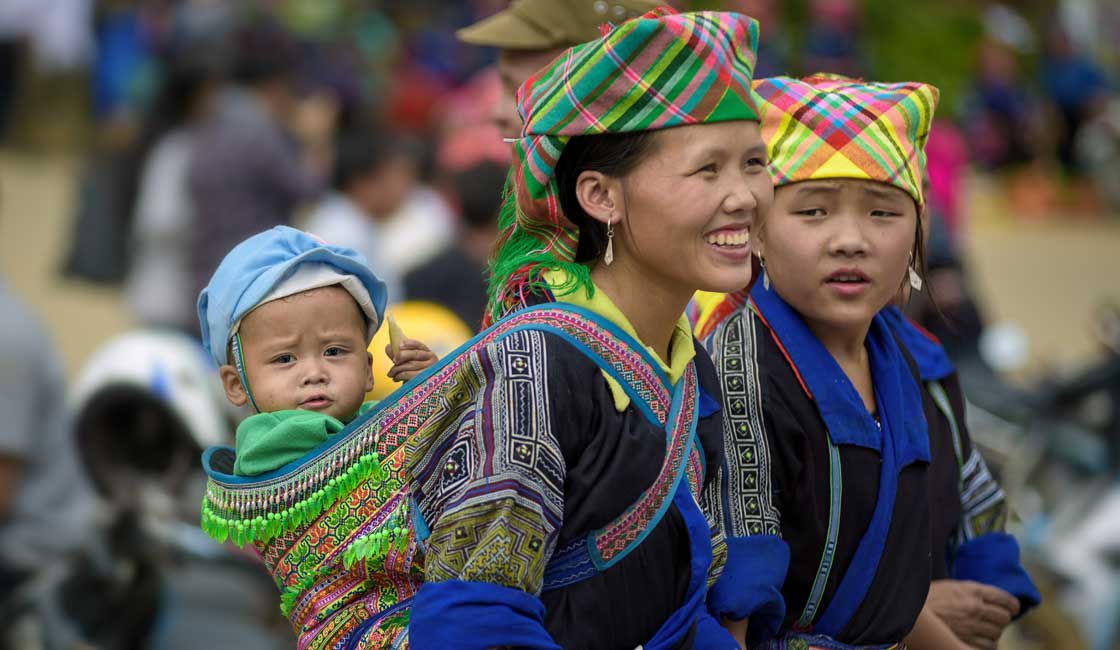
Mục Lục
Let’s break it down
Modern-day Vietnam is recognized as a multi-ethnic country, with one main ethnic group known as Kinh (or Viet), and 53 ethnic minorities of varying sizes. There are around 14 million indigenous people in Vietnam. It’s a hefty wedge of the national population which is roughly 95 million, making it one of the most populous countries on Earth.
The make-up of the different ethnic groups is, understandably, very complex. Ethnologically, they can be split up into eight main groups, of which there are multiple sub-groups. The eight principal groups are:
- Vietic
- Austroasiatic
- Tai
- Kadai
- Tibeto-Burman
- Malayo-Polynesian
- Hmong-Mien
- Chinese
In each of these, there are several different ethnic groups of different sizes. The biggest ethnic groups with over 500,000 members include the H’Mong, Nung, Khmer-Krom, Hoa, Muong, Dao, Tay, and Thai. The smallest groups number at just a few hundred members in each, such as the Brau, O Du, Ro Mam, Pu Peo, and Si La. These groups of ethnic minority people can be found mostly across the hilly and highland areas (which make up over three-quarters of Vietnam) up the length of the country, from the Central Highlands, up the Truong Son mountain range, and into the northern hills.
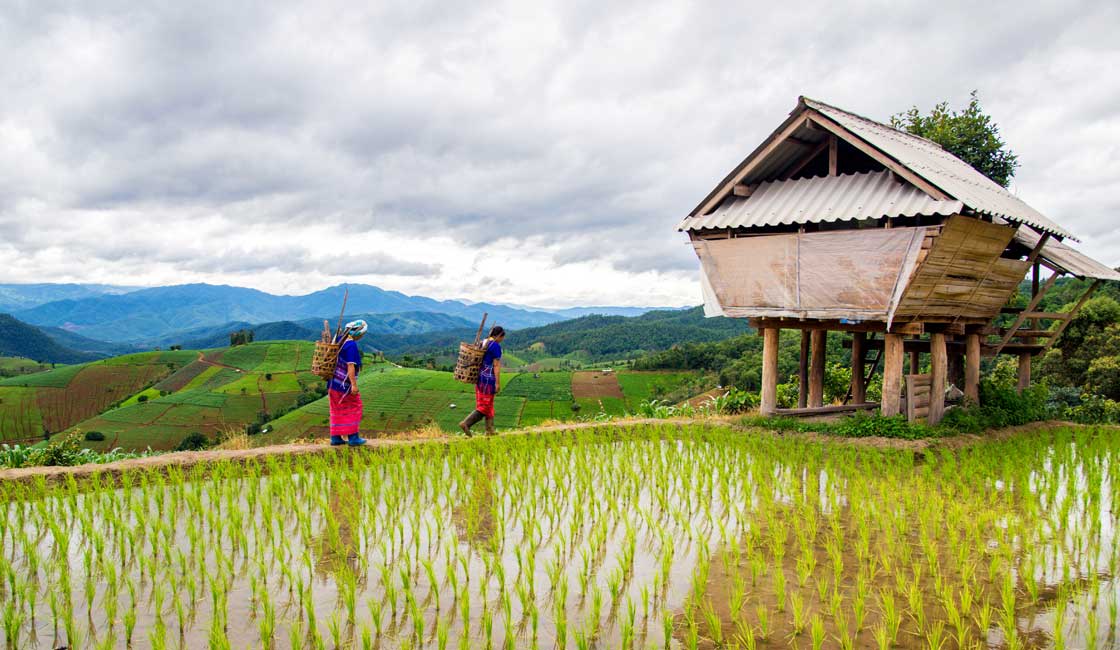
Children of the Dragon King
We’d all like to think that we’re descended from dragons and fairies, right? Well, legend has it that the people of Vietnam are descendants of a mighty dragon king from the south called Lac Long Quan and a Chinese immortal fairy queen called Au Co. They got married and had one hundred children (in some variations this offspring hatched out from one hundred eggs).
They didn’t live together for long, however, because the dragon king was a water creature and the fairy queen was of the land. Soon, the dragon king missed the low country and so he took half of his children and headed back towards the sea where he’d come from. His eldest son became the first king of the Hong Bang period, known as the Hung Kings. The other half remained with Au Co and headed up into the mountains, and these became the ancestors of today’s mountain people or hill tribes.
Farfetched it may be, but in many cases, myths and legends can have some truth to them. The legend of Lac Long Quan and Au Co certainly accounts for the immense divide in lowlanders (ethnic Kinh/ Viet) and highlanders (ethnic minority groups). This idea of two different peoples, the coastal people, and the land people have seeped into the country’s legends and religions – the pairing of the elements of earth and water.
Where it all began
In reality, we have very little to go on when talking about the origins of Vietnam’s ethnic minorities. Most historians believe that the first people of Vietnam arrived over land and sea and gathered initially in the Red River Delta of the Gulf of Tonkin in the north of Vietnam. These early peoples were called the Lac or Lac Viet.
There are many theories about the historical origins of Vietnam’s minority people. Some believe that all the ethnicities are descended from the same original cultural group, and eventually became different due to geographical isolation. At some indistinguishable point, the Kinh/ Viet became distinct from other indigenous groups and evolved into the country’s dominant culture.
Others think that these tribes originated in different places in East and Southeast Asia. The hill tribes of the north are descended from migrants of Southern China, eventually settling in the northern borders of Vietnam. Other tribes are people originally from Malaysia that were at one point forced into the highlands. Others are descendants of the kingdom of Champa that once existed across central and southern Vietnam and the Khmer Empire that ruled over the Mekong Delta.
What we can be sure about, however, is that today, the numerous ethnic minorities of Vietnam are all unique and have their own distinct lifestyles. Some will have been there for thousands of years, inhabiting the land long before the early Viet moved down from Southern China, while other tribes are perhaps just a few hundred years old.
A place to call home
So where do the different ethnic groups all live? The dominant population of Vietnam, the Kinh/ Viet live in the lowlands and coastal areas such as the Mekong River Delta, the Central Coastal Delta, and the Red River Delta, and the big cities.
When it comes to the minority groups, although some small groups do live down on the coastal plains still, on the whole, they inhabit the upland areas. The hills of the north, the Central Highlands, and Vietnam’s portion of the Annamese mountains run parallel to the country’s coastline. There are some groups that exist on the country’s borders, and actually straddle the line between Vietnam and Southern China. The village communities are usually separated by different altitudes – generally speaking, the older tribes existing further down the hillsides and the later tribes settling further up. The tribes that inhabit the Central Highlands are often called Montagnards – a vestige of French rule, coming from the French word for mountain.

What do they wear?
When it comes to traditional dress, Vietnam is a veritable treasure trove. The clothing that is worn throughout the different ethnic groups varies substantially and is utterly transfixing. While most ethnic groups in other Southeast Asian countries have fantastic wardrobes, Vietnam’s tribes differ in that they wear their colorful traditional garb no matter what the activity – from traveling, working in the home to farming, and everything in between. With 53 ethnic minority groups in total, the different styles are endless, but here is a selection of a few colorful cultural outfits
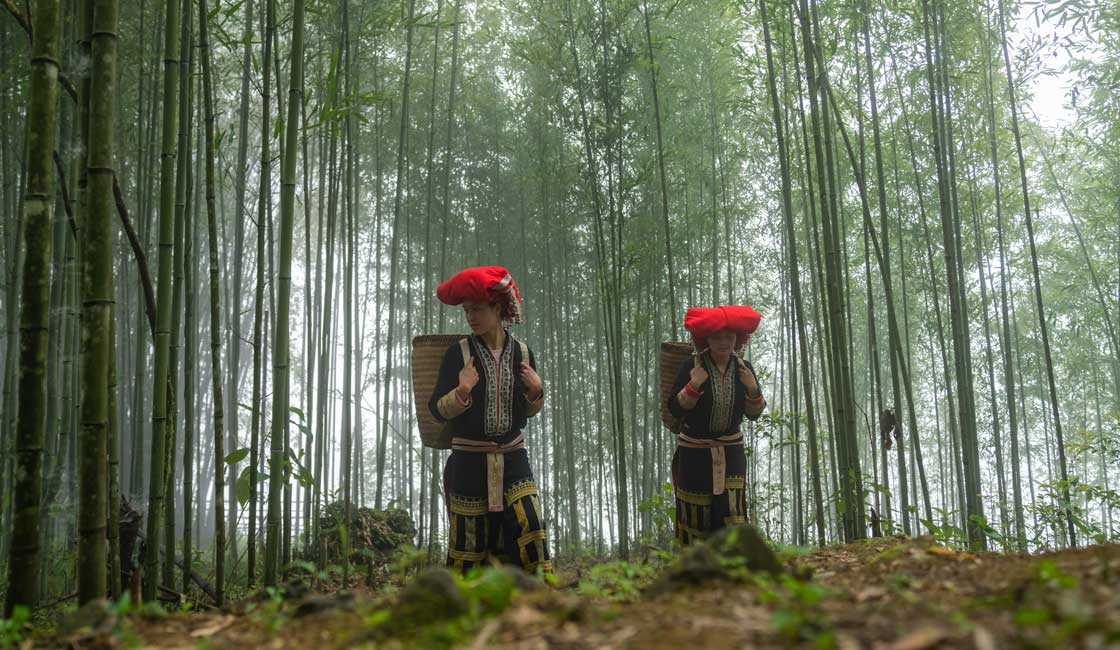
The Dao
The Dao is renowned for its fantastic costumes. Women wear huge red headdresses and large pieces of silver jewelry, and men wear pants with ornate embroidery depicting scenes of village life and symbols of animist spirits. Clothing is often adorned with tassels, studs, and silver coins.
The Brau
The Brau tribe is one of the smallest in the whole of Vietnam with only 397 members still left, living in the village of Dak Me. The women of this ethnic group wear long, heavy ear jewelry that stretches their earlobes, and many members of the tribe tattoo their bodies. There is a custom here to file the front teeth down to be even as part of coming of age.
The Ha Nhi
The Ha Nhi belong to the Tibeto-Burmese language group and inhabit northern Vietnam. Their authentic costumes include extravagant headdresses with ribbons, pompoms and beads, multi-colored clothing with tassels, and hand-embroidered geometric borders.
The Lao Lu
Weaving and fabric work is a big deal among the Lao Lu people, and they make their own clothing from naturally dyed pieces of cotton and silks. Women are not allowed to marry until they’ve mastered the art of weaving their own clothes. Intricate colorful patchwork patterns have been passed down the generations to form beautiful pictorial strips of birds and flowers.
The Thai
Thai people make up the second-largest ethnic minority after the Tay ethnic group, with over one million people. Within this group, there are culturally distinct tribes that can be distinguished by their wonderful clothing. The Black Thai dress all in black, the Red Thai wear red headdresses, and the White Thai attach small white pieces of cloth to their belts.
The Black Lo Lo
In Cao Bang Province in northeast Vietnam, you can find a hill tribe called the Black Lo Lo, who live in traditional houses on stilts high up in the mountains. The clue’s in the name when it comes to their traditional dress – you can distinguish them from the other hill tribes of the area by their black clothes. This cultural clothing is decorated with appliquéd ribbons sewn into geometric patterns, in the colors of yellow, green, and pink.

The Hmong
The Hmong arrived in Vietnam around 500 years ago, mostly living around the town of Sapa in northwestern Vietnam. The different Hmong tribes have their own costumes, often made from hemp, from multicolored headdresses to traditional long dresses. They are incredibly skilled textiles artists, with a heritage of techniques from beeswax batik shirts to cross-stitched collars. Women of the Hmong tribe wear indigo-dyed clothes with beautiful embroidery and jewelry, with large headdresses, while the men tend to wear Western clothes. The Flower Hmong, in particular, are known for their stunningly vibrant clothing, covered in hand-stitched appliqué and colorful fringes.
The Lo Lo of Lung Cu
Most of the time, Lo Lo of Lung Cu wear everyday clothing – similar to the Kinh or Viet. However, on special occasions such as festivals, they don their traditional outfits. An incredible fashion show of decorated and ornate clothes, the skills that they exhibit in their ceremonial costumes have to be seen to be believed.

The Flower Lo Lo
In Ha Giang Province, Flower Lo Lo is dedicated to their craft and their traditional dress consists of thousands of colorful triangles hand-stitched together. This takes an unbelievable amount of time and effort – one dress takes roughly an entire year to stitch. As such, they’re kept safely locked up for most of the year and only aired at special festivals and celebrations.
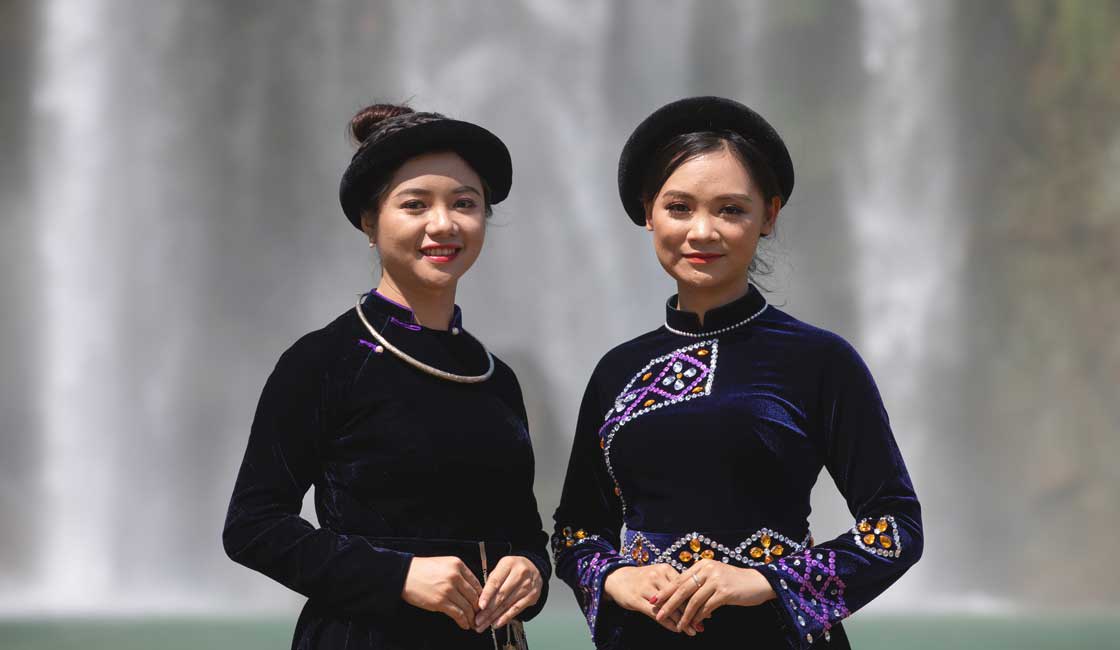
Life in the hill tribe
Although there are obvious differences from tribe to tribe, it is possible to pick out similarities too. Those that live in the northern parts share quite a few characteristics – they sometimes even intermarry and do business with one another. Most groups center around large community markets such as the wonderful markets of Sapa and Bac Ha. This isn’t just a place to buy and sell for them – it’s the heart of their community, a place to share culture, to court future spouses, to form friendships. The concept of community and kinship is important in most ethnic groups, as is a fierce desire to protect and preserve indigenous cultural identity.
Agriculturally speaking there tends to be two main types of ethnic groups – sedentary and nomadic. Most are sedentary, and they farm rice terraces and cultivate stationary crops. The nomadic communities practice swidden farming (also known as slash-and-burn farming), where areas of forest are cleared by burning, and the ash is absorbed into the soil preventing pests and providing fertility. The areas are farmed for a few years and then left to recover fertility – meanwhile, another patch is farmed.
What languages do they speak?
As you can imagine, with this number of cultures, the language systems are wildly diverse and complex. Over a dozen different languages and multiple dialects exist throughout the ethnic minority groups, and there’s a range of theories as to their linguistic heritage. Roughly speaking, each language and its respective dialects can fit into three main language groups – the Austro-Asian, the Malayo-Polynesian, and the Sino-Tibetan.
What are their homes like?
A common feature of many hill tribe villages is the iconic stilt house. This elevated structure gives protection against flooding and unwanted creatures such as rodents, snakes, and other dangerous animals, as well as providing shelter for livestock and pets. In other tribes, houses are constructed with compacted soil, and all the neighbors join together to build each house. The women work together to cut the thatch, while the men join forces to chop the timber for the house frames. Because the houses are earthen-walled, construction must happen in the dry months of between September and January.
Today, some communities have taken on more modern and efficient building materials such as fibro-cement for the roof. Three grains of rice are thrown down into the foundation as a blessing for bumper crops, healthy livestock, and a large family. Gardens are constructed close to the homestead, and the houses themselves are generally basic with one room consisting of a bed and a kitchen.
What religions do they follow?
Just like language, the subject of religion in the ethnic minorities of Vietnam merits a thesis of its own! For the most part, highlanders are animists when it comes to religion. Animism is the belief that all things – animals, plants, even inanimate objects have some sort of spiritual essence. Practitioners of animism carve shrines and totems to honor the natural world. If you come across these shrines, it’s important to respect their beliefs and not to touch or disturb them. It’s also believed that children could be taken by evil spirits if they are named before a certain age.
Other religions found amongst Vietnam’s ethnic minorities are Buddhism (Theravada, Mahayan,a or Hinayana), Islam, Hinduism, Catholicism and Protestantism, and other faiths.

Issues they face
The main concern for many ethnic minorities around the world is a rapidly marching monoculture, driven by westernized ideas of progress and development. Because of this, smaller ethnicities tend to face a number of issues today that leave their futures hanging in the balance.
For Vietnam’s tribal populations, poverty is a massive problem. According to recent studies, the national poverty rate in Vietnam is 7%, while the registered poverty rate for ethnic minority groups is as high as 23%.
Their methods of agriculture have been challenged by the Vietnamese government, which recognizes the environmental damage that a slash-and-burn culture can have on the land. With forests that are quickly disappearing, there are now subsidies and other encouragements (like better health care and education) in place to persuade tribes to practice sedentary agriculture with crops like tea, cinnamon, and coffee.
So far as westernization, the levels really vary from group to group. Some groups have been assimilated into mainstream Vietnamese culture and don’t even wear traditional clothing. In some groups, the women still present in authentic garb while the men wear similar clothes to the ethnic Kinh/ Viet. Some remote villages, however, are still completely off-grid and maintain traditions. The same goes for things like electricity and other modern luxuries – it varies hugely from tribe to tribe, some with the odd antenna for television, while most are yet to use these modern technologies. The last few decades have seen a rise in ethnic tourism, which has, in turn, introduced international influences to previously isolated tribes.
Loss of heritage and cultural identity is a valid fear for many of Vietnam’s ethnic minority groups, and this is what makes these people so significant. One effort to share the beauty and immense diversity of the Vietnamese people is a photography project by artist Réhahn, who spent the best part of a decade capturing intimate and authentic moments throughout Vietnam’s hill tribes. The result is called The Precious Heritage Project and some of the photos are available to see online.
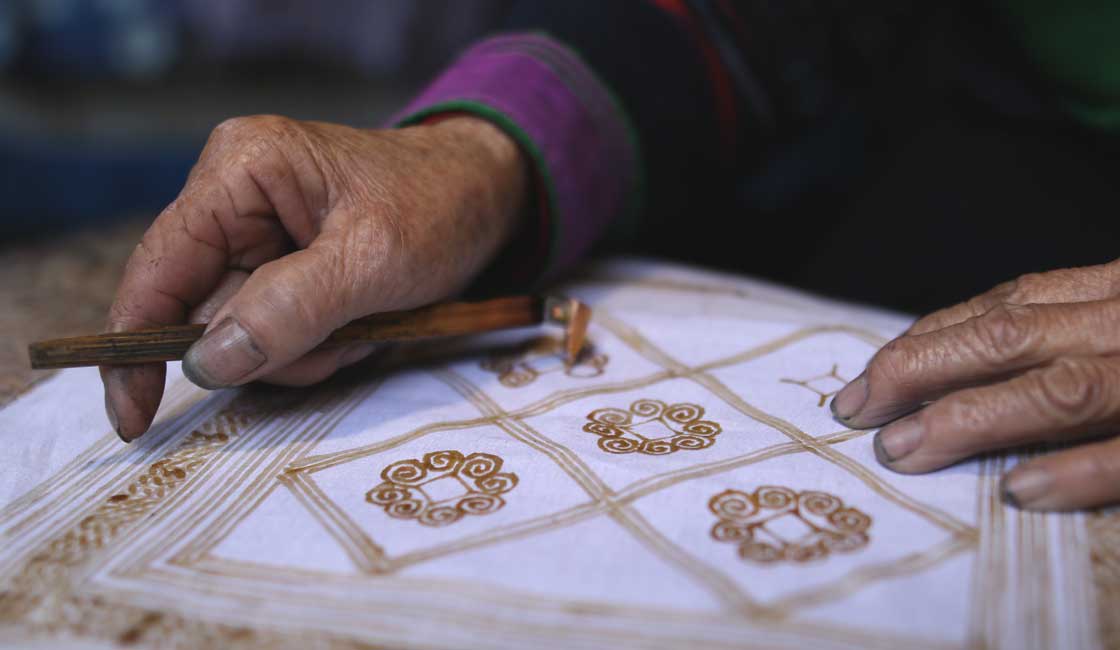
A list of dos and don’ts
Amazingly, it’s possible to witness the ancient ways of many of these people in places throughout Vietnam, such as Sapa, Mai Chau, and Ha Giang. Some tribal populations live in larger communities that trade together (despite language barriers!) and others are very welcoming to tourists visiting their villages and sometimes in very special situations, their homes. In general, members of ethnic groups are renowned for their hospitality, wide welcoming smiles, and generosity. However, it’s good to remember a few key rules if you are planning to visit a tribal village or community:
- Only take photos of people or places if the people in the photo (or the owners of the buildings) have given you permission. Do not pay people to appear in your photographs.
- Do not presume that they speak your language. You might find that the locals don’t let on that they can’t speak English so you should be prepared to use gestures and signs or the translation of a guide when communicating.
- Buy souvenirs. In many of the villages, there will be opportunities to show your gratitude for their hospitality by purchasing a gift or trinket.
- If you’re presented with food or drink you don’t feel up to trying, be polite and graciously decline.
- In Vietnam, rice wine flows constantly! Be aware that it’s good manners in Vietnam to continue to refill glasses and plates until told otherwise. You can turn your bowl upside down to imply you’re finished and don’t want any more.
- The Vietnamese, like many Southeast Asians, are generous with their smiles. Smiling is often a go-to response in many situations, even when apologizing for something or to get through an awkward situation. Good to remember in cases where something’s gone wrong – you might get a smile rather than an empathetic or worried face!
- Do not touch anything unless invited, especially sacred objects.
- Wear respectful clothing – appropriate dress is long pants or skirts, and long-sleeved tops.
- Mature travelers – don’t be offended if you’re treated slightly differently. You may be offered seats on public transport, or helped across roads. They are just being polite, not assuming you’re too old to manage!
- Most importantly, do not leave any trace that you’ve been there. Remember that you are very privileged to be able to witness a rare and magical culture, and behave respectfully at all times.
That wraps up our tour of the tribes and ethnic minorities of Vietnam! Who knew that this Southeast Asian country was so jam-packed full of ethnic groups? There’s something very inspiring about imagining that as we go about our daily lives, elsewhere in the world ancient traditions are being upheld, and life is lived at a different pace. Vietnam might now have to move even higher up that travel bucket list.






